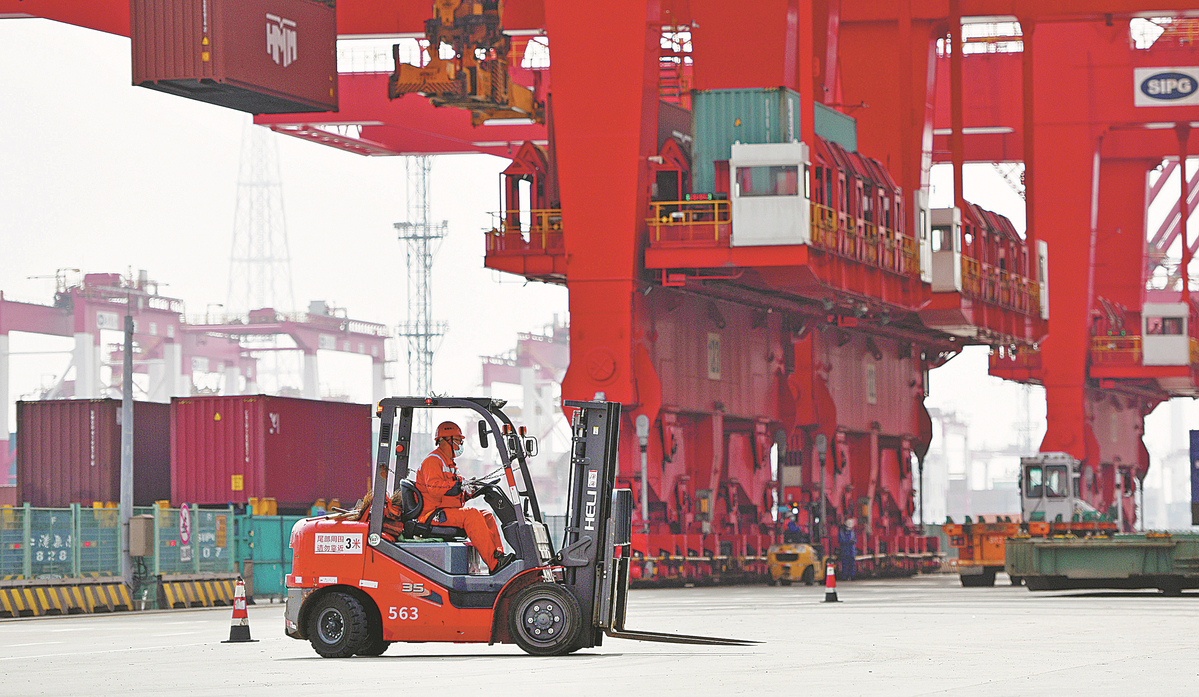Shanghai's supply chain returns despite COVID


City bounces back as global trade leader in sea and air shipping, with export volume to SE Asia recovered by 80% to 90%
Shanghai Port, the world's busiest container port, has seen a rapid recovery in operating volume since June. Even during the days when the city was hit hard by the COVID-19 outbreak, transportation across the region was maintained thanks to the effective collaboration of ports and related organizations in the Yangtze River Delta region, showing the resilience of the area's supply chain, said industry experts.
The amount of daily export declarations at Yangshan Deep Water Port, one of Shanghai Port's main units, has soared more than 50 percent to 11,000 from the previous 7,000, China Securities Journal reported, citing data from Yangshan Customs.
Yangshan Port contributed more than half of the container throughput at Shanghai Port, which has been rated as the world's largest container port for 12 consecutive years. The port's container throughput volume exceeded 47 million twenty-foot equivalent units (TEUs) in 2021.
Entering June, exports from East China rebounded, especially shipments to the Association of Southeast Asian Nations (ASEAN), which is China's biggest trading partner. Export volume from Shanghai Port to Southeast Asia has recovered to between 80 percent and 90 percent of that in March, according to YQNLink, a global intelligent logistics platform based in Shanghai.
Shanghai Port reported its container throughput amounted to 18.75 million TEUs between January and May, approaching the same volume as last year's 18.85 million TEUs. Daily container throughput at Shanghai Port has approached its normal level as of the middle of June, the Shanghai Municipal Transportation Commission said on its official WeChat account.
"With the city's production and life coming back to normal, the city's functions as an international shipping center are being restored at an accelerated pace," it added.
More than 20,000 employees of Shanghai Port working under closed-loop management at the port areas have ensured the port's normal operations around the clock, even during the period hit by COVID-19 outbreak.
"During the pandemic, some cargo was handled via surrounding ports, and others were shipped to Shanghai Port by water routes instead. The coordination between the region's ports and related organizations has ensured the supply chain to and from Shanghai continues. And this is proof of the resilience of our supply chain, or to be more specific, logistics chain," said Lin Guolong, director of the Logistics Research Center at Shanghai Maritime University.
Lin said that at the beginning of building Shanghai into a global shipping center, a highly developed water network across the Yangtze River Delta region had started planning and development.
Compared to other transportation methods like highways and high-speed railways that are also well developed in the region, water routes are more economical and environmentally friendly. What's more important, the water network played an important role in supporting the supply chain during the pandemic, Lin added.
"In April and May, many exporters along the Yangtze River ran into difficulties in delivering exported goods to Shanghai Port to meet the delivery schedule of their customers in Southeast Asia, Russia, Japan and South Korea. We quickly found alternative solutions for those enterprises, which is to use feeder vessels to ship cargo to Shanghai Port from the closest port without increasing expenses," said Zhou Shihao, founder and CEO of YQNLink, a Shanghai-based international digital logistics platform.
"The smooth replacement of highways with water routes cannot be realized without advanced digital platforms, which enable us to quickly connect and coordinate resources, and allow logistics to rotate with high efficiency during the pandemic," Zhou said.
According to Zhou, YQNLink improved its digital operating system during the pandemic to efficiently match supply and demand at global ports, terminals, shipping operators and railways, helping quickly find alternative solutions.
Likewise, based on its more than 140 vessels and over 40 shipping lines along the Yangtze River, China COSCO Shipping Corp Ltd has launched an alternative service of water routes at 55 ports along the Yangtze River to ease the challenges that may occur during road transportation. The group's 95 ships operating along the nation's coastal area are both responsible for the shipping of COVID-19 prevention goods and people's livelihood materials, as well as exports, according to the Shanghai-based company.
In the meantime, ocean-rail transportation was launched in Jiangsu and Zhejiang provinces to solve the escalating shortage of container lorries. All these efforts were made in a bid to keep logistics moving freely along the supply chain.
COSCO Shipping Lines Co Ltd also contributed its worldwide smooth coordination and operation to digital technology, online booking, e-commerce platforms, blockchain, as well as online filing, marketing and services, among others.




































